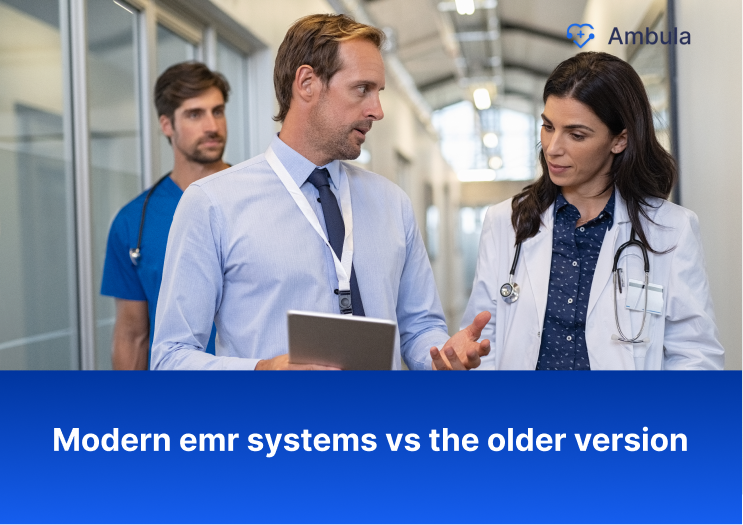
This article explores the history and evolution of Electronic Medical Records (EMR) systems, from the early attempts in the 1960s to modern cloud-based systems. It examines the drawbacks of traditional EMR systems and the benefits of current EMR software. The article will explore the potential of modern EMR systems to improve healthcare delivery and patient safety through this discussion.
- History of EMR system
- Negative side of Traditional EMR systems
- Modern EMR software
- What is the latest technology used in modern emr software?
History of the EMR system
The history of EMR systems dates back to the 1960s when the first attempts at computerizing patient data were made. The first EMR systems were designed to store and process patient information, including medical history, diagnoses, lab results, and medications. As technology advanced, EMRs increased sophistication and scope, incorporating features like decision support and patient tracking. By the 1990s, EMRs had become essential to the healthcare industry, allowing clinics, hospitals, and other healthcare facilities to manage patient records and improve patient care more efficiently. Today, EMRs are used by nearly all healthcare providers and are seen as essential tools for improving patient care, reducing costs, and increasing efficiency.
Negative side of Traditional EMR systems
Traditional EMR systems are computer systems healthcare providers use to store and access patient information. These systems are typically installed in the provider’s office and require staff to be physically present to manage them. They are usually older, more expensive than cloud-based systems, and have limited functionality. Traditional EMR systems generally require manual data entry and are not as interoperable as current cloud-based systems. Additionally, they cannot take advantage of the latest technologies and lack the features offered by cloud-based systems. These systems are also more challenging to maintain and upgrade since they must be manually managed on-site.
Modern EMR software
Modern EMR software is vastly different than the old version. It offers a range of features that make it easier and faster to document patient information, such as automated data entry, pre-populated components, and alerts for potential errors. The software is also designed to be more efficient and user-friendly, allowing healthcare professionals to securely and accurately capture patient information. Additionally, modern EMR software is integrated with other systems, such as billing and lab systems, allowing for greater interoperability and improved patient safety.
What is the latest technology used in modern emr software?
1. Cloud Computing
Cloud computing is increasingly being used in EMR software. Cloud-based EMRs provide healthcare organizations with a secure, cost-effective, and reliable way to store and share patient information. Cloud-based EMRs also give healthcare organizations access to powerful analytics and data mining tools, enabling them to quickly and accurately assess patient needs and develop targeted treatments and interventions. Additionally, cloud-based EMRs allow healthcare organizations to quickly and easily scale up or down their operations to accommodate changing needs.
2. Artificial Intelligence (AI)
AI algorithms have been incorporated into EMR software to streamline data entry, improve diagnostics, and provide personalized patient care. AI-driven applications can quickly recognize patterns in medical data and suggest treatments or diagnostics that may not have been considered. AI-driven medical record management can help reduce medical errors by reducing the time it takes to enter and access patient data. AI-enabled EMR systems can also provide healthcare professionals with real-time patient data that can be used to inform treatment decisions. By leveraging the power of AI, healthcare providers can provide the most accurate and up-to-date care for their patients.
3. Natural Language Processing (NLP):
NLP is being used to understand and interpret unstructured medical data. It can be used to detect patterns in patient records and to make sense of medical terminology. This enables medical professionals to make more informed decisions and improve patient care. Additionally, NLP can be used to develop personalized treatments and provide better patient outcomes.
4. Mobile Technology
Mobile technology has become integral to modern EMR systems, allowing doctors and healthcare professionals to access patient data anywhere. This has enabled more efficient and accurate care delivery and better coordination between healthcare providers. Additionally, mobile technology in healthcare has created more tailored and personalized patient care. This has been done through mobile applications that allow patients to access their medical information, have direct contact with healthcare providers, and even monitor their health data.
Conclusion
In conclusion, EMR systems have come a long way from their inception in the 1960s. Modern EMR software utilizes the latest technology to provide healthcare organizations with secure, cost-effective solutions for managing patient records. Cloud computing, artificial intelligence, natural language processing, and mobile technology are all used to improve patient care, increase efficiency, and reduce costs. By leveraging these technologies, healthcare providers can provide the most accurate and up-to-date care possible.




